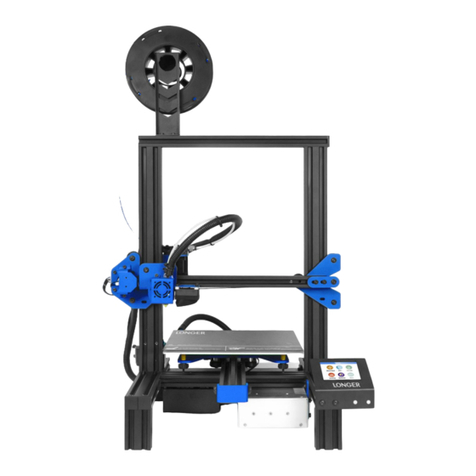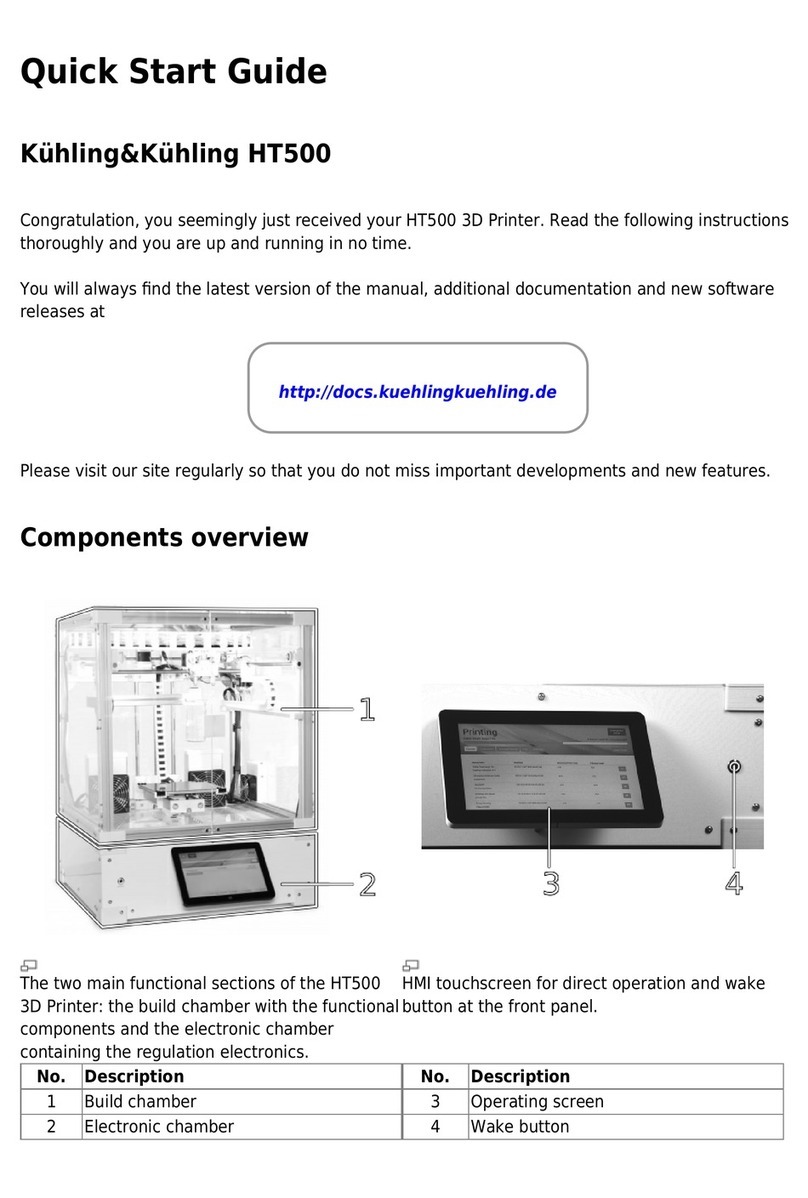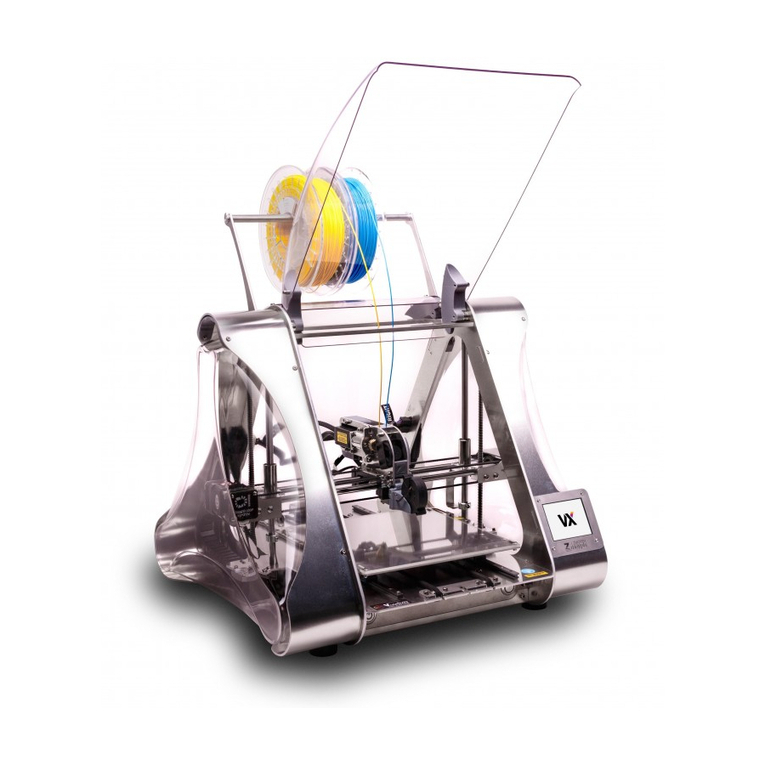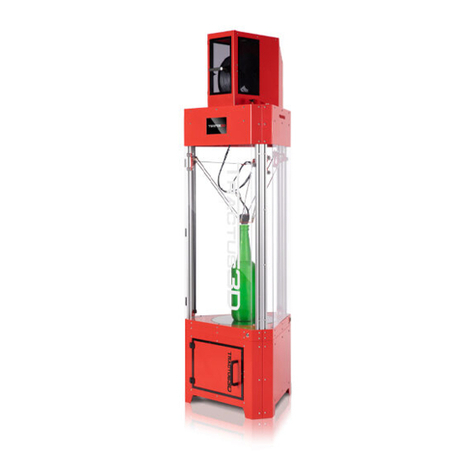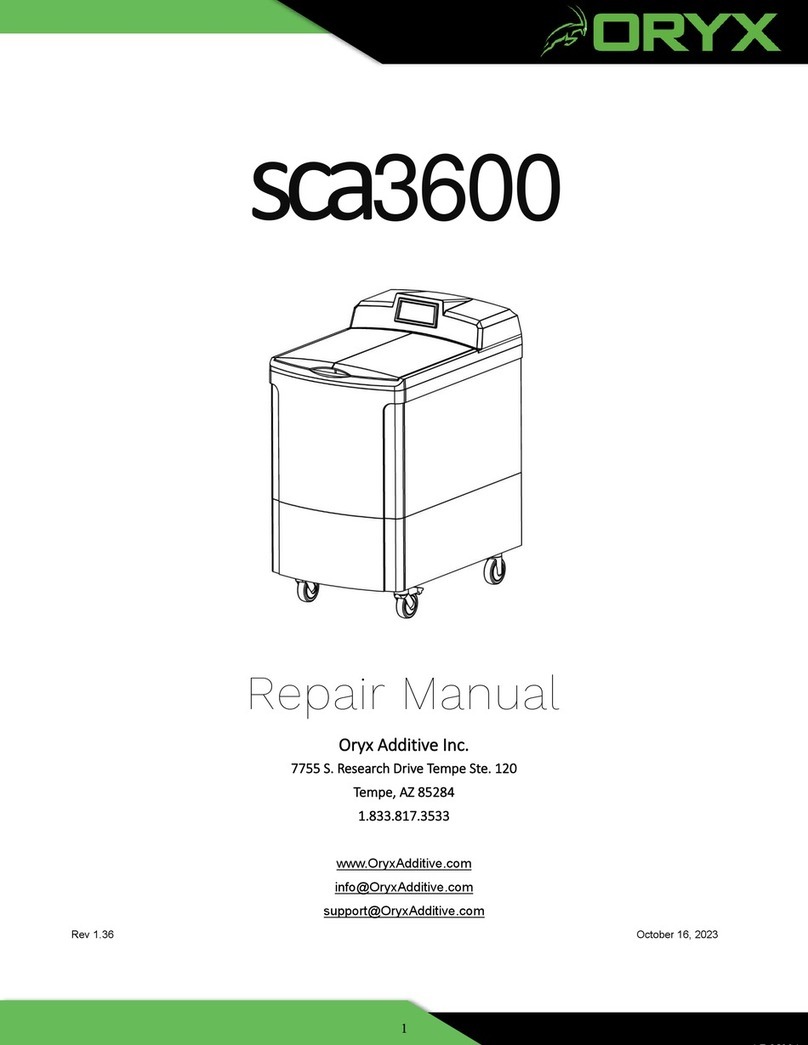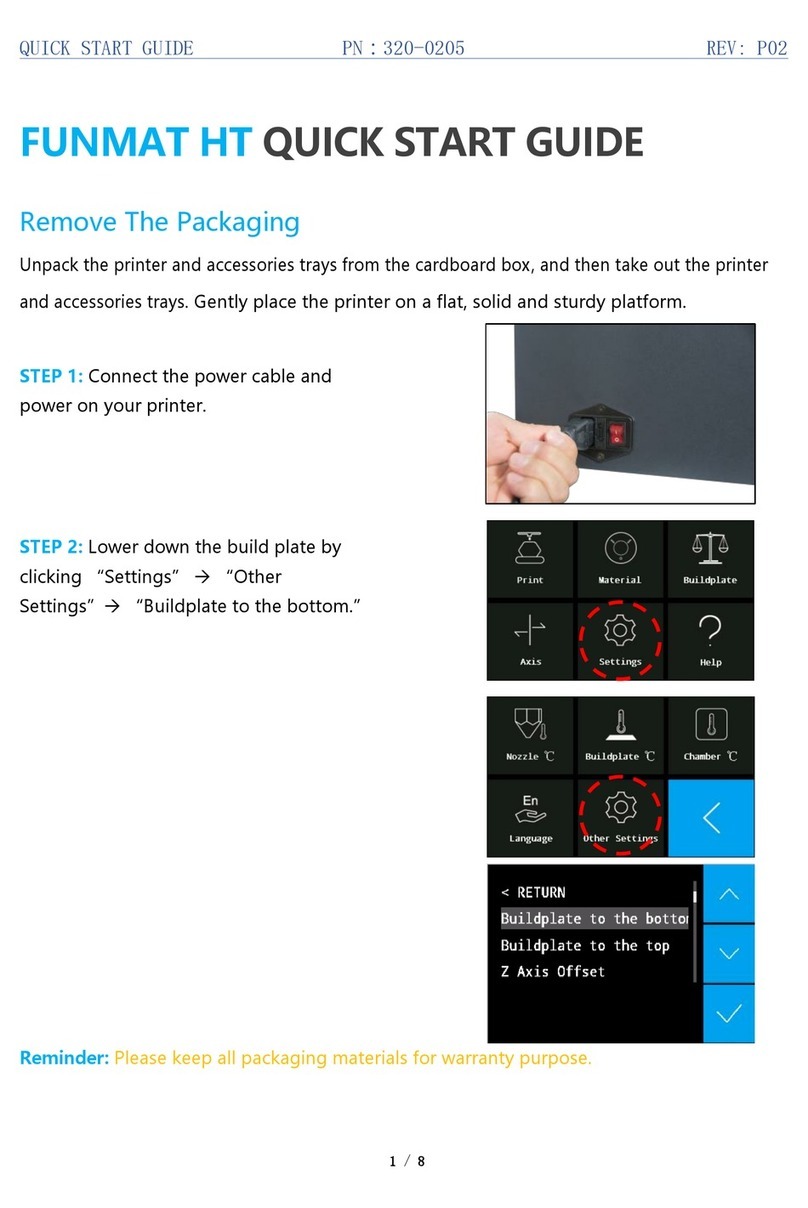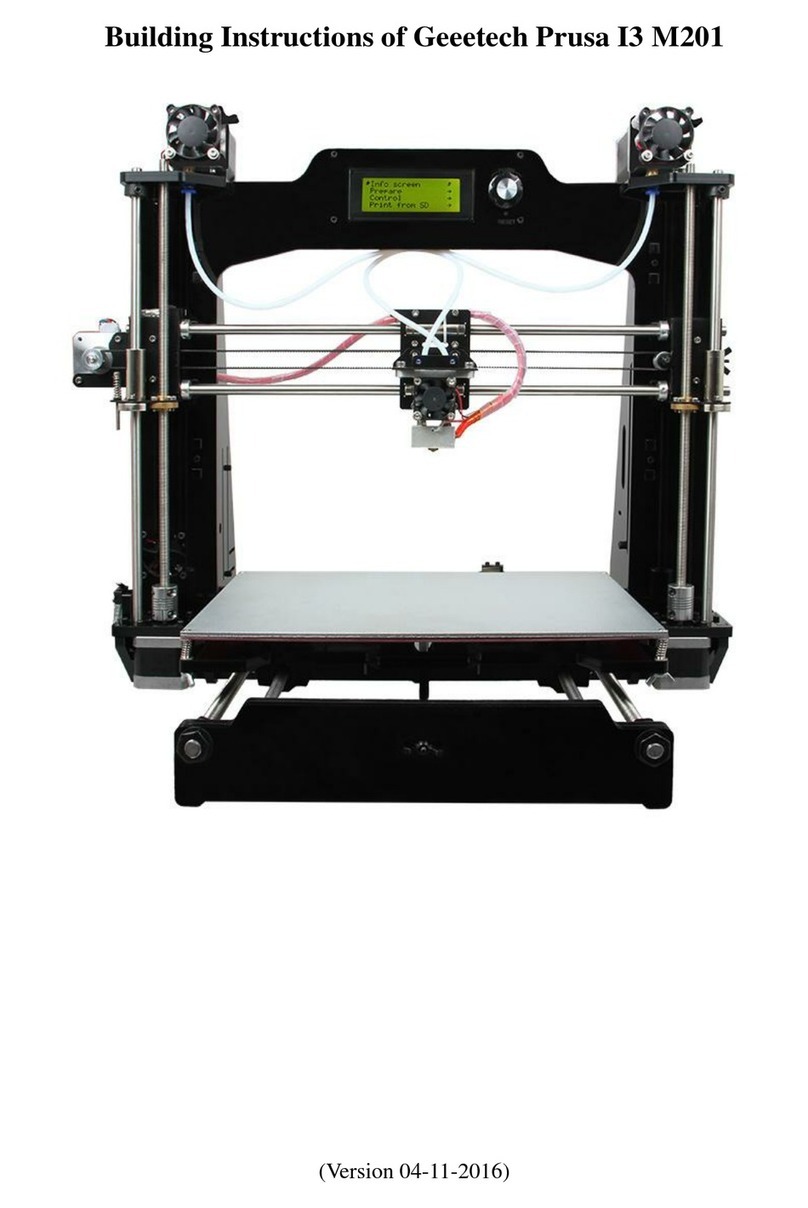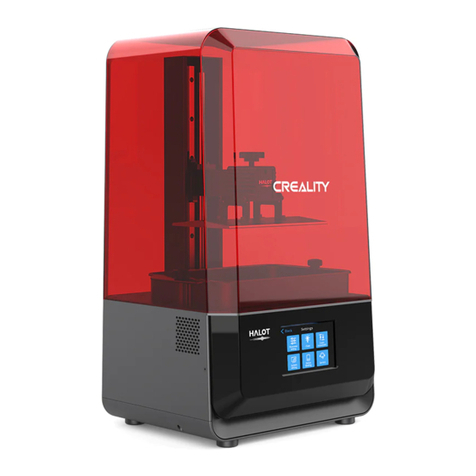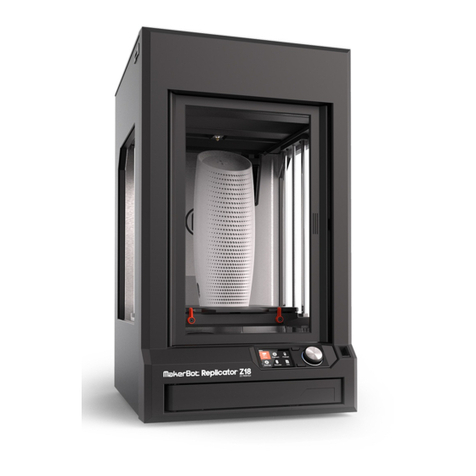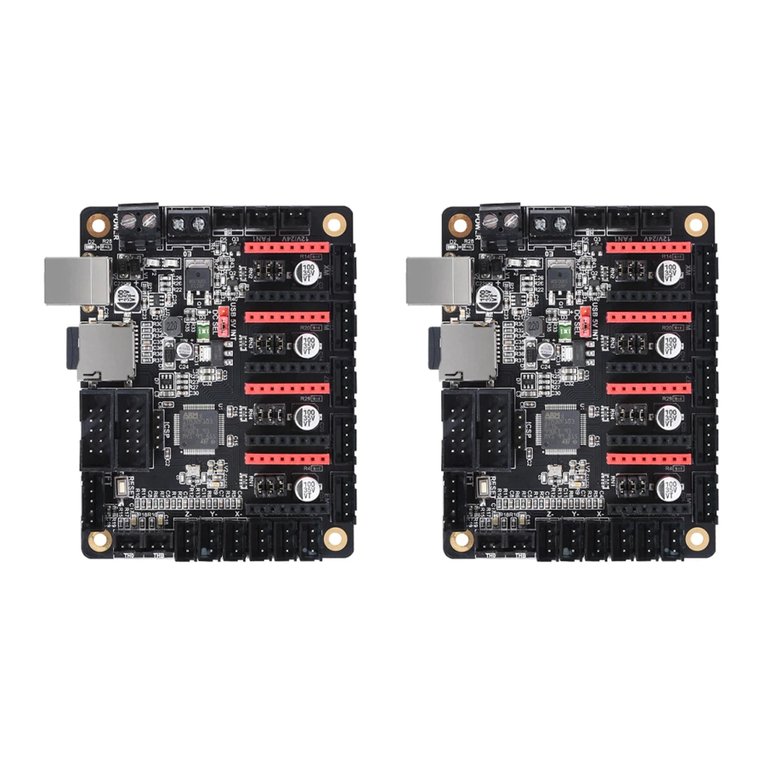Kossel Pulley User manual



Safety Instructions
Please read the safety instructions carefully before get started.
ANYCUBIC 3D printer generates high temperature. Do not reach
inside of the printer during operation. Allow time for the printer to
cool down after printing. Contact with the extruded material may
cause burns. Wait for printed objects to cool before removing them
from the build platform.
ANYCUBIC 3D printer includes moving parts that can cause injury.
Vapors or fumes may be irritating at operating temperature. Always
use the ANYCUBIC 3D printer in an open, well ventilated area.
Be cautious when using the scraper. Never direct the scraper
towards your hand.
The ANYCUBIC 3D printer MUST NOT be exposed to water or rain.
The ANYCUBIC 3D printer is designed to be used within ambient
temperature ranging 8ºC-40ºC, and humidity ranging 20%-50%.
Working outside those limits may result in low quality printing.
In case of emergency, immediately turn off the ANYCUBIC 3D
printer.
It is recommended to use protection glasses when cleaning/sanding
printed models to avoid small particles contacting eyes.
Never leave the ANYCUBIC 3D printer unattended during operation.

Technical Specification
PRINTING
Printing Technology: FDM (Fused Deposition Modeling)
Build Size: Ø 180× 300 mm (Ø 230× 300 mm for Linear Plus)
Layer Resolution: 0.1-0.4 mm
Positioning Accuracy: X 0.01mm
Y0.01mm
Z0.01mm
Extruder Quantity: Single
Nozzle Diameter: 0.4 mm
Print Speed: 20~80mm/s
Travel Speed: 150mm/s
Supported Print Materials: PLA, ABS, HIPS, Wood
TEMPERATURE
Ambient Operating Temperature: 8ºC - 40ºC
Operational Extruder Temperature: 275ºC
Operational Print Bed Temperature: N/A
SOFTWARE
Slicer Software: Cura
Cura Input Formats: .STL, .OBJ, .DAE, .AMF
Cura Output Formats: GCode
Connectivity: SD Card, USB Port (expert users only)
ELECTRICAL
Input Rating: 100-240V AC, 50/60Hz, 1.5A
PHYSICAL DIMENSIONS
Printer Dimensions: 315mm (Δ) × 680mm (Height)
380mm (Δ) × 680mm (Height) for Linear Plus.
Weight: ~5kg-Pulley, ~6kg-Linear, ~6.8kg-Linear Plus

Shenzhen Anycubic Technology Co., Ltd.
Assembly Instructions
Mechanics .....................................................................................................................1
1. Top and bottom triangle..................................................................................1
2. Effector...............................................................................................................3
3. Slide guide (Linear and Pulley) .......................................................................5
4. Main frame .......................................................................................................8
5. Belts....................................................................................................................9
6. Extrusion system..............................................................................................10
Circuit ..........................................................................................................................11
7. Mainboard ......................................................................................................11
8. LCD ..................................................................................................................14
9. Platform ...........................................................................................................14
Setup............................................................................................................................16
1. Driver Installation ...........................................................................................16
2. Firmware uploading.......................................................................................16
3. Parameter settings ..........................................................................................18
4. Printing.............................................................................................................20
FAQ..............................................................................................................................23

Shenzhen Anycubic Technology Co., Ltd.
Parts List
No.
Items/Quantity
No.
Items/Quantity
A01
Top triangle × 3
B01
XYZ Motor × 3 (with wire)
A02
Bottom triangle × 3
B02
Print head set × 1
A03
Effector × 1
B03
4010 fan × 1 (with wire & end)
A04
Horseshoe fixture × 1
B04
4010 air blower × 1 (with wire & end)
A05
Radiator cover × 1
B05
Limit switch × 3
A06
Air nozzle × 1
B06
Wire for limit switch× 3 pairs
A07
Belt tensioner × 3
B07
Wire terminal for limit switch × 3
A08
Stop blocks × 6 (Pulley× 3)
B08
Extrusion motor × 1
A09
Carriage × 3 (Pulley only)
B09
ANYCUBIC mainboard × 1
A10
Extrusion bearing holder × 1
B10
Al-fin × 5
A11
Extrusion fixture × 1
B11
A4988 driver × 5
A12
Extruder rack × 1
B12
LCD 2004 × 1 (with pin board & wire)
A13
Shaft sheath × 1
B13
USB wire × 1
A14
Mainboard holder × 1
B14
Power adaptor × 1
A15
LCD cover × 1
B15
SD card × 1
A16
Limit blocks for print platform × 6
C01
M5*25 screw × 9 (Pulley only)
D01
240mm Al-extrusion × 9 (300mm for
Linear Plus)
C02
M3*20 screw × 9
D02
680mm Al-extrusion × 3
C03
M3*16 screw × 17
D03
Idler wheel × 3
C04
M3*12 screw × 1 (Pulley × 14)
D04
Synchronizing wheel × 3
C05
M3*10 screw × 8
D05
Carbon fiber tube set × 6
C06
M3*8 screw × 50 (Pulley × 20)
D06
450mm Linear rail × 3 (Linear only)
C07
M2.5*12 screw ×11
D07
Pulley wheel (Bearing) × 9 (Pulley only)
C08
M2*5 screw × 8
D08
4.5m Synchronous belt × 1
C09
Ø4-7-0.5 washer × 2
D09
Belt tension spring × 3
C10
M3 flange nut × 18 (Linear only)
D10
Extrusion wheel × 1
C11
M4 square nut × 67 (Pulley × 64)
D11
Extrusion bearing × 1
C12
M5 hex nut × 9 (Pulley only)
D12
Extrusion spring × 1
C13
M4 hex nut × 3
D13
M6 Quick connector × 1
C14
M3 hex nut × 16 (Pulley × 19)
D14
0.6m PTFE feeding pipe × 1
C15
M4*8 screw × 6
D15
0.8m Strap × 1
C16
M4*10 screw × 59 (Pulley × 56)
D16
PTFE washer × 4
C17
M4*12 screw × 1
D17
Ø200mm Glass plate × 1 (Ø240mm for
Linear Plus)
C18
M4*25 screw × 3
Other
Hex key set (1.5/2/2.5/4mm) × 1
Rubber glove × 1 pair
Test filament × 1

Shenzhen Anycubic Technology Co., Ltd.
1
Mechanics
Fasteners Listing
Note: A flat surface is recommended for the assembly. Hex keys are available within the
package. Take care of the scrap when unpack Al-extrusions and keep it away from children.
1. Top and bottom triangle
Step 1. Firstly, hang but not tighten 5 pairs of C16 and C11 onto A01 as shown in Fig 1.
Then push an Al-extrusion (D01) through two screws along A01 and tighten the
corresponding screws. Lastly, fix one pair of C13 and C18 onto A01 as shown in top-left.
Fig 1
Step 2. Place 3 pieces of assembled A01 and D01 on a flat surface with back side face
down, as shown in Fig. 2. Then, follow the blue arrows, slowly push forward those 3 parts to

Shenzhen Anycubic Technology Co., Ltd.
2
form a triangle and tighten the corresponding screws (red arrows).
Fig. 2
Step 3. Fig. 3 shows the assembly details of one of the three corners of the top triangle.
Fig. 3
Step 4. The assembly of bottom triangle is the same as the top, except 10 pairs of C16 and
C11 and 2 pairs of short Al-extrusion are used for A02, which is show in Fig. 4.
Fig. 4
Step 5. After 3 pieces of assembled A02 are ready, push them forward simultaneously to
form the bottom triangle and then tighten the corresponding screws, just as Fig. 5 shows.

Shenzhen Anycubic Technology Co., Ltd.
3
Fig. 5 Fig. 6
Step 6. Fig.6 shows the assembly of 3 stepper motors. After assembly, using C06 to fix those
motors to each corners of the bottom triangle as demonstrated in Fig. 7. Make sure the
sockets of the motors face up.
Fig. 7
2. Effector
Step 1. Before installation, detach the heat rod and thermistor from the hot end set. Then
install the Hot End to the radiator cover (A05) by a horseshoe (A04), as shown in Fig 8.
Leave the C06 screws untightened in order to adjust the hot end angle later if necessary.

Shenzhen Anycubic Technology Co., Ltd.
4
Fig. 8
Step 2. As shown in Fig. 8 (3) and (4), find the suitable angle to fix the Hot End into A03.
Then fix the heat rod and thermistor back. After, use 4 pieces of C08 to fix the air nozzle
(A06). Lastly, fix B03 and B04 (fans) to the correct side of the radiator cover.
Step 3. Fix 6 carbon fiber tubes (CFT, D05) onto A03 using C03 screws, as shown in Fig. 9.
Fig. 9
Step 4. Fig. 10 shows the assembly of 3 belt tensioners which connected to the CFTs. Please
note the suggested height of the top screws (C07) is 8mm.

Shenzhen Anycubic Technology Co., Ltd.
5
Fig. 10
3. Slide guide (Linear and Pulley)
The operation of effector depends on the linear motion of each belt which is connected to
stepper motor. The type of motion guide is divided into Linear and Pulley. The assembly of
those two types will be introduced in the following section.
First of all, find 3 pieces of long Al-extrusions and fix them from the upper side to the bottom
triangle as shown in Fig. 11. If choose the wrong side, the Al-extrusion would not fit in. Next,
tighten the corresponding screws at each corner which is shown by red arrows.
Fig. 11
The following section is interpreted based on two different types, Linear and Pulley.
(1) Linear Version
Step 1. Firstly, hang 6 pairs of C06 and C10 with proper interval onto the linear rail (D06)
as demonstrated in Fig. 12. In total there are 3 rails and the assembly is the same.

Shenzhen Anycubic Technology Co., Ltd.
6
Fig. 12
Step 2. Prepare 2 pieces of stop blocks (A08) with C16 and C11. Then push down one of
the stop blocks, the linear rail, and the other stop block sequentially along with the long
Al-extrusion as shown in Fig. 13. The suggested distance between the stop block and the top
of the long Al-extrusion is 30mm. Do the same to the rest of the 2 long Al-extrusions.
Fig. 13
Step 3. Use 4 screws (C06) to fix belt tensioner onto the linear rail as shown on the left of Fig.
14. Then do the same to the rest as shown on the right side of Fig. 14.

Shenzhen Anycubic Technology Co., Ltd.
7
Fig. 14
(2) Pulley Version
Step 1. As shown in Fig. 15, fix 3 pulley wheels (D07) to the carriage (A09) using 3 pairs of
C01 and C12. Insert C14 into the dash-circle area and fix a C04 screw from the side. Do
not over tighten or twisting the carriage. Do the same to the rest of 2 carriages.
Fig. 15
Step 2. As shown in Fig. 16, fix the prepared belt tensioners to the carriage sets using C04.
Fig. 16
Step 3. Slide down those 3 carriages along with each Al-extrusion. Then fix 3 stop blocks
using C16 and C11 and the suggested distance from the stop block to the top is 30mm.

Shenzhen Anycubic Technology Co., Ltd.
8
Fig 17
4. Main frame
The assembly of main frame and limit switches is the same for both Linear and Pulley
version. Here we take Linear version for example.
Step 1. Fix the limit switches (B05) to each of the stop blocks as shown in Fig. 18.
Fig. 18 Fig. 19
Step 2. As shown in Fig. 19, install the top triangle frame to the main structure. Meanwhile
adjust the screws (red arrows) to level the upper surface of the triangle frame with the top of
each Al-extrusion. Fasten the 3 screws on the side (green arrow) after leveling.
Step 3. Install one end of the wire (B06) to the limit switch through the top triangle frame (no
positive and negative). Lead the other end of the wire passing through the hole of the
Al-extrusion and the holes of the bottom triangle, which is shown in Fig. 20. After that, fix

Shenzhen Anycubic Technology Co., Ltd.
9
the bottom end of B06 into the terminal of B07. Do the same to the rest of limit switches.
Fig. 20
5. Belts
The assembly of belt is the same for both Linear and Pulley version. We take the Linear
version for example. Divide the belt into 3 equal parts. Fix one end of a belt onto the belt
tensioner as shown in Fig. 21-1. Thread the belt through the top guiding wheel, then the
bottom synchronizing wheel, and lastly fix the other end of the belt back to the belt tensioner,
Fig. 21-4. Do the same to the rest of 2 belt parts. If necessary, use the belt tension spring
(D09) to adjust the tightness of the belts.
Fig. 21
D09

Shenzhen Anycubic Technology Co., Ltd.
10
6. Extrusion system
Fig. 22
Step 1. As shown in Fig. 22, firstly fix the extrusion wheel (D10) onto the shaft of the
extrusion motor (B08). Make sure the fastening screw is facing the plane of the shaft. Notice
the distance between the extrusion wheel and the motor is about 3mm. Next, install the
extrusion bearing with 2 washers onto the bearing holder as shown on the right of Fig. 22.
Step 2. The assembly details (from right to left) of the extruder are shown in Fig. 23. The
socket of the extrusion motor is suggested to face down (blue dash circle).
Fig. 23
Step 3. As shown in Fig. 24, lie down the main frame and choose one of the 3 long
Al-extrusions to fix the extruder on by using 2 pairs of C15 and C11. The position of the
extruder should be a bit lower from the middle, which could be seen in the cover page. Next,
find the quick connector (D13) and the feeding pipe (D14) and fix them onto extruder.
Fig. 24

Shenzhen Anycubic Technology Co., Ltd.
11
Step 4. Insert the other end of the feeding pipe to the other quick connector on the effector.
If you wish to pull out the feeding pipe, please press down the black plastic ring then release
the pipe. Do not force the pipe out by twisting or tearing.
Fig. 25
Circuit
7. Mainboard
Step 1. Fix ANYCUBIC mainboard (B09) to the holder (A14) using 3 pairs of C06 and C14.
Fig. 26
Step 2. There are 5 pieces of A4988 (B11) in the package. Prepare 4 pieces (the rest is for
backup) of A4988 with Al cooling fin, as Figure 27 shows. Make sure the Al fin does not
touch the pin on A4988 to avoid any short passing.
*A method to calculate the drive current of A4988: use a multimeter to test the voltage
between the two points on A4988, which is pointed out by two red arrows as shown in Fig.
27; then the current (I) can be calculated by the equation of I=U/0.8. Normally the voltage
ranges from 0.75 to 1V, so the current should be in the range of 0.94~1.25A.

Shenzhen Anycubic Technology Co., Ltd.
12
Fig. 27
Step 3. As shown in Fig. 28, mount 4 pieces of square nuts (C11) into the corresponding
position on bottom Al extrusion, and fix ANYCUBIC mainboard using 4 pieces of C15. Note:
in Fig. 28, 3 motors are named as X, Y, Z respectively in order to make the
wiring/interpretation clearer in the following paragraph. The assembly position of
ANYCUBIC mainboard could be referred to those 3 motors.
Fig. 28
Step 4. Next, as shown in Fig. 29, fix 4 pieces of A4988 onto ANYCUBIC mainboard. Pay
closely attention to the configuration and direction of the drivers and board to avoid any
unnecessary problem/damage during use.

Shenzhen Anycubic Technology Co., Ltd.
13
Fig. 29
Step 5.
The wiring of the mainboard is explained as follows (Figure 30). Before wiring on
ANYCUBIC mainboard, please make sure the wires on effector passing through the carbon
fiber tubes, as shown in Figure 31.
Fig. 30
a. The assembly of A4988 has been mentioned previously.
b. Limit switches (ENDSTOPS): please see the bottom right in Fig. 30. 1. X+ wire to X
motor limit switch; 2 Y+ wire to Y motor limit switch; 3. Z+ wire to Z motor limit switch.
c. Thermistor: wire the thermistor terminal from the printing head to T0.

Shenzhen Anycubic Technology Co., Ltd.
14
d. Motors: X, Y, Z slots are for X, Y, Z motors respectively. There are 2 slots for Z motor,
please choose any one of them. E0 is for extrusion motor. (E1 is for expansion function
such as two extruders).
e. Heat rod: wiring from printing head to Heat 0 port (without positive and negative).
f. Fan: connect the 4010 cooling fan to FAN 2 slot, while connect the 4010 blower fan (for
model cooling) to FAN 0 slot. Red line wires to positive terminal and black one wires to
negative terminal.
g. Power and USB: when everything is ready, connect power supply to the power port and
USB line to the USB port.
When wiring is finished, use straps (D15) to arrange the wires from printing head, as shown
in Fig. 31. The wire-cluster could be fixed to one of the carbon fiber tubes by ribbon, but do
not let it to restrict or interfere with the motion of the printing head.
Fig. 31
8. LCD
Firstly prepare the LCD with the LCD cover (A15) and other fasteners as shown in Fig. 32.
Then use the cables to wire EXP1 and EXP2 from mainboard to LCD. Lastly, fix the LCD to
the bottom Al-extrusions, just as shown in Fig. 32.
9. Platform
As shown in Fig. 33, install 6 pieces of limit-blocks (A16, including right and left parts) onto
the bottom triangle frame using 6 pairs of C16 and C11. Then put the glass platform onto
A16 and adjust its position accordingly. Lastly, fasten those screws to fix the platform. Then
you could fix the ANYCUBIC platform sticker onto the glass platform.
This manual suits for next models
2
Table of contents
Popular 3D Printer manuals by other brands
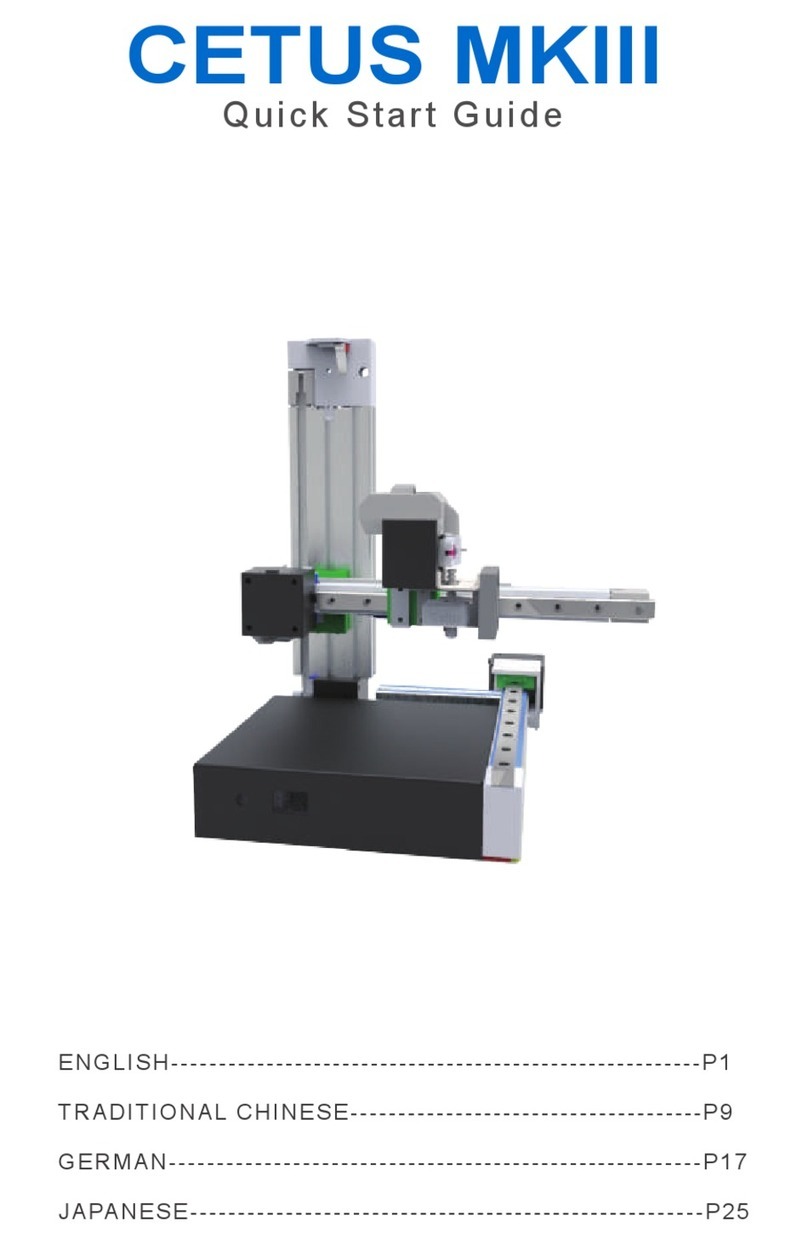
Wuxi Tiertime Technology
Wuxi Tiertime Technology CETUS MKIII quick start guide
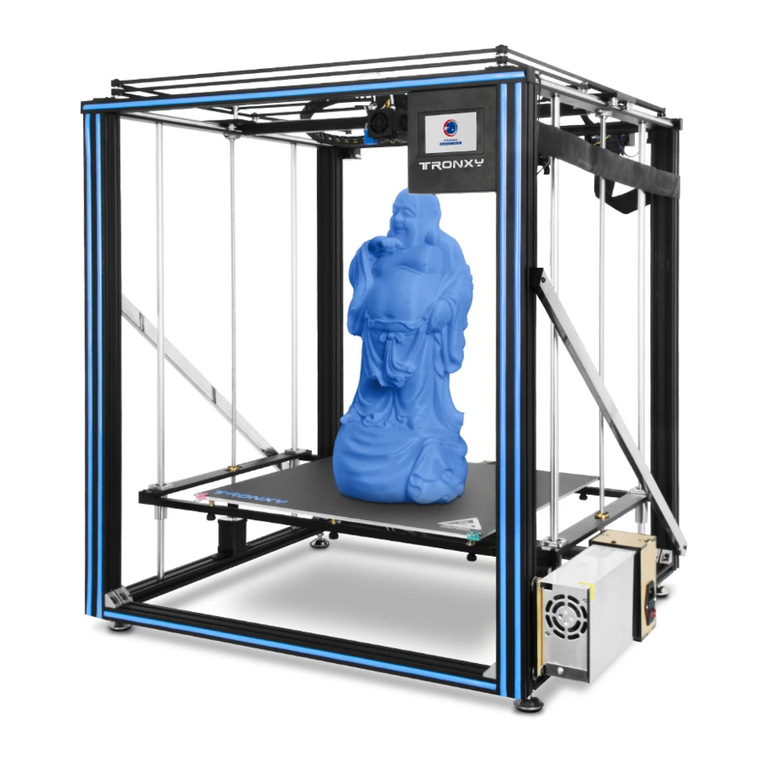
TRONXY
TRONXY X5SA-500-PRO user manual
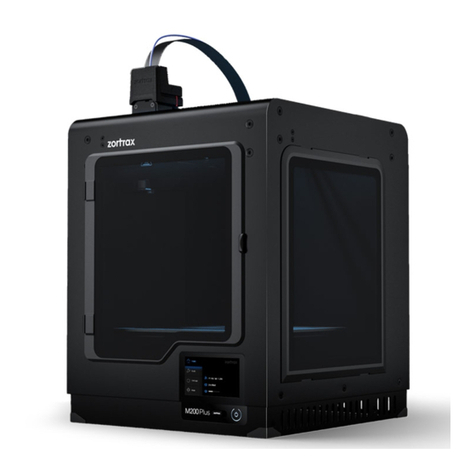
zortrax
zortrax M200 Plus Troubleshooting: Camera Preview Is Blurred
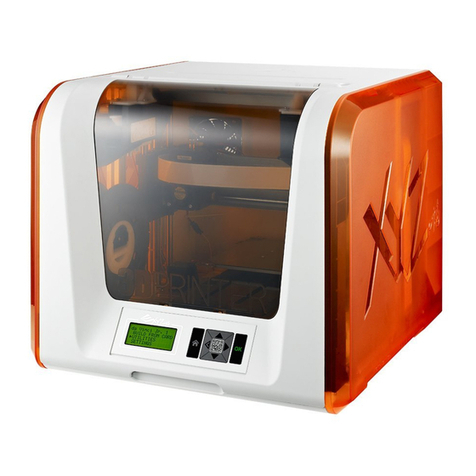
XYZ Printing
XYZ Printing da Vinci Jr. 1.0 user manual

bq
bq hephestos Assembly manual
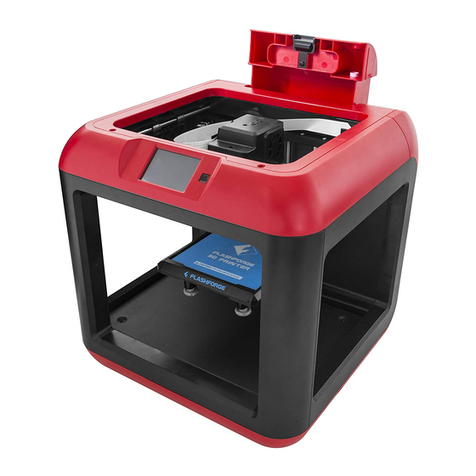
Flashforge
Flashforge Finder user guide
